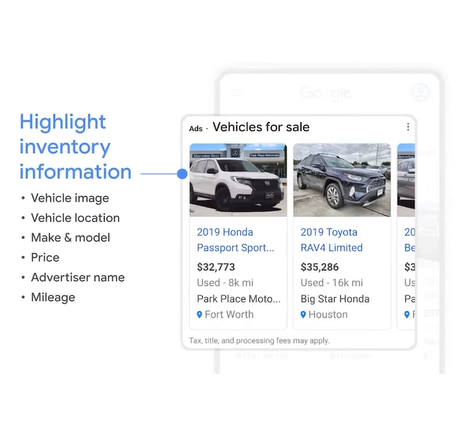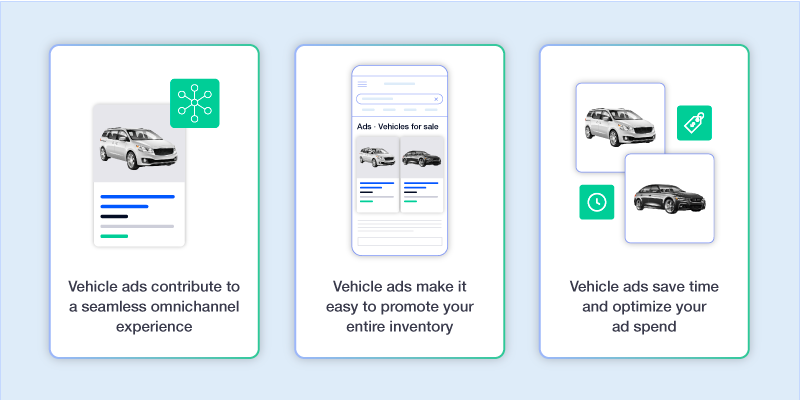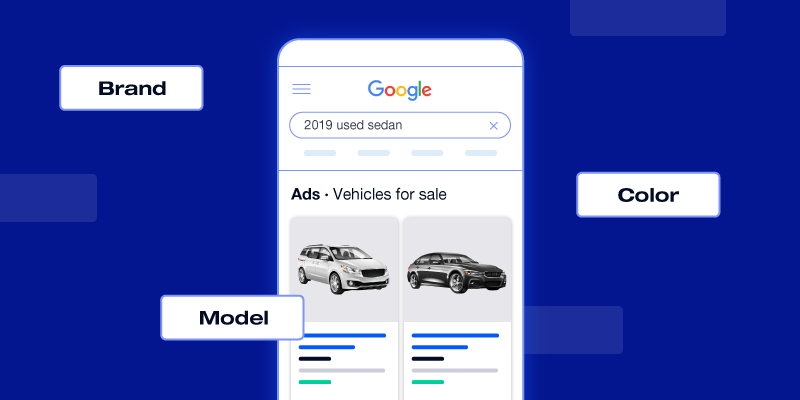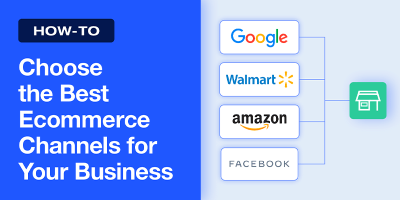According to Google, 92% of car buyers do research online before they make a purchase. As a result, Google has introduced a new ad type, the vehicle ad, to better serve shoppers and car dealerships. With this new campaign, Google streamlines the vehicle buying process by providing shoppers with more relevant information about the vehicle they’re looking for.
Keep reading to learn more about vehicle ads and see tips from Feedonomics’ Cofounder and Chief Architect, Brian Roizen, on how dealerships and auto advertisers can best use them.
What are Google’s vehicle ads?
Before vehicle ads, a common digital ad strategy for auto retailers was to use Google search ads with keywords for all the makes and models an auto seller had in stock. These text-only ads appear at the top of a user’s search results.
Though these ads still serve a purpose, they do not allow sellers to market individual cars for sale. Instead, they promote the general make and model of cars that dealers have on hand. If a customer is looking for a specific car model within a certain mileage range, it isn’t easy to find the car they want in a single search.
To improve the car shopping experience, Google unveiled vehicle ads. This dedicated ad campaign for car dealers makes it easier for shoppers to research and find the exact car they are looking to buy. Vehicle ads show shoppers the car’s image, make, model, year, mileage, price, new or used status, and advertiser’s name.
Source: Google
How do vehicle ads work?
Currently, vehicle ads can only be used to advertise new or used non-commercial passenger vehicles in the United States.
To get started, you need to set up a Google Merchant Center account, a Google Ads account, and a Google Business Profile for your dealership. Though a business profile isn’t required if you are uploading a store feed, it is a good idea if you wish to drive in-store visits to your business. After the three profiles are set up, you must complete a form to enable the vehicle ads program.
Once you complete these steps, it’s time to upload a vehicle inventory feed in the Google Merchant Center for your dealership. This process is similar to uploading a product feed for Google Shopping.
Vehicle Ads Inventory Feed Requirements
Your inventory feed must include these required attributes for each car listing:
- Google Product Category: Use Vehicles & Parts > Vehicles > Motor Vehicles > Cars, Trucks & Vans
- Vehicle Fulfillment: Acceptable options include in-store, ship-to-store, and online
- VIN: Vehicle identification number
- ID: Internal stock identifier or VIN is acceptable
- Store Code: Each code must match the store codes submitted within your dealership’s Google Business Profile
- Image Link: URL of the vehicle you are promoting
- Link Template: URL parameter added to your vehicle’s landing page that includes your store code, ex: carsforyou.com/101?store={store_code}
- Link: Only required for online-only ads. It is a link to the landing page on your desktop website that includes specific vehicle details.
- Price: This must match the price on your vehicle’s landing page
- Vehicle MSRP: The manufacturer’s suggested retail price is required for new vehicles and optional for used vehicles
- Condition: Accepted values are used or new
- Brand: Name of the car’s manufacturer
- Model: The model of the car you wish to promote, without mention of the trim level
- Year: The vehicle’s model year
- Mileage: Ensure you include the mileage in both kilometers and miles
- Color: You can submit up to three colors separated by “/”
For further details on how to get started with vehicle ads, please follow Google’s step-by-step implementation guide, as well as the feed creation guide for more information about required and optional data attributes.
Once you upload your feed, Google uses the data to generate your vehicle ads. Shoppers who click on an ad are directed to your website’s dedicated product page for the advertised car. From there, they can connect with the dealership to learn more, schedule a test drive, or even purchase the vehicle.
Some required attributes in your inventory feed do not appear on the display ad, but Google still uses the information to accurately match shoppers with relevant search results. The main goal of vehicle ads is to reach customers at the bottom of the sales funnel, when they know exactly what they want and are close to making a purchase. Google combines customer insights with your feed data to get your vehicle inventory in front of the right customers.
Key benefits of Google’s vehicle ads

Vehicle ads contribute to a seamless omnichannel experience
Vehicle ads make connecting with car shoppers online and offline even easier. Advertisers can choose to target online conversions through online lead forms or offline conversions with physical dealership visits. With these automotive Google ads, shoppers can move from researching a vehicle to purchasing one with less browsing.
Vehicle ads make it easy to promote your entire inventory
Vehicles Ads use the data provided in your inventory feed and are not reliant on building out a series of keywords for each car line you sell. They also make it easy to share the most significant details about a car at first glance, rather than forcing the customer to search through a website or catalog of listings.
Vehicle ads save time and optimize your ad spend
Just like Performance Max, vehicle ads are fully automated. Vehicle ads allow Google’s algorithm to optimize your campaign for specific goals that you identify as most important to your business. This, in turn, saves your team time as there is less to manage. With automated bidding, Google uses machine learning and audience signals to maximize conversions and get the most out of your budget for your automotive ads.
Vehicle ads case studies
Let’s look at a few companies that have had great success using vehicle ads!
Asbury Automotive Group
Asbury Automotive Group’s focus was to tackle the industry shift of buyers researching cars online. The team’s goal was to connect their vehicle inventory with these online searchers. While also using traditional search ads, Asbury Automotive Group built its vehicle inventory feed to promote the company’s line of used vehicles. In doing so, the team found that its total conversions increased by 35% while each conversion’s value also increased by 12%.
Ken Garff
Ken Garff Automotive Group wished to reach more customers both online and offline at its nine dealerships, so the team created an inventory feed and implemented vehicle ads. Ken Garff Automotive Group found that the new ad campaign drove 55% more conversions and drove more in-store visits than its other campaigns.
Tips for getting better results with vehicle ads
Before you get started, be sure to follow these insider tips from Feedonomics’ Cofounder and Chief Architect, Brian Roizen, on how to get the most out of your vehicle ad campaigns:
Tip #1 Optimize your vehicle inventory feed data
The best way to increase the chances of your vehicle ads reaching valuable customers is to provide Google with as much information in your inventory feed as you can. There are feed attributes that your vehicle inventory feed must include to be approved, but there are also several optional attributes that dealerships can include. If you are unsure if your vehicle feed is up to snuff, our feed experts would love to run a free feed audit to help improve your feed.
Tip #2 Make sure your vehicle landing page is optimized, mobile-friendly, and quick to load
After a customer clicks your ad, it should be easy to learn more about the vehicle and how to contact you. Making a customer dig through a landing page to find more information increases your bounce rate and leaves the customer with a negative experience. It is also important to note that 53% of customers will abandon your website if it takes more than three seconds to load. So be sure your website speed is fast, and you don’t have too many plug-ins, large images, or random scripts weighing your site down.
Tip #3 Keep using search campaigns
Even though vehicle ads simplify advertising for dealerships, the original strategy of using vehicle keywords is still very useful. Vehicle ads should be used alongside traditional search campaigns. Creating several digital touchpoints throughout the buyer’s journey is the best way to reach your target audience. Google found that advertisers saw a 25% increase in conversions when using vehicle ads to complement existing search campaigns.
Tip #4 Keep your product data accurate
If you sell used cars, you might only have a single car in stock for particular makes and models, so it’s important to frequently update your inventory and product data to ensure you never accidentally oversell any of your vehicles. This can become an even bigger issue when you sell or advertise on multiple ad platforms and marketplaces. Feedonomics for Advertising helps synchronize your data across all of your channels, optimize your inventory feed, and resolve feed-based errors to ensure your customers have the most up-to-date information and an excellent customer experience.
Enhance your vehicle ad campaigns with Feedonomics
Ready to get started with vehicle ads? Our expert feed specialists can help you scale your campaigns and optimize your vehicle product feeds to reach more customers.

With its leading data feed management platform, Feedonomics helps brands, retailers, and agencies optimize and list products on hundreds of shopping destinations around the world. Learn more about our full-service solutions for advertising channels and marketplaces.



